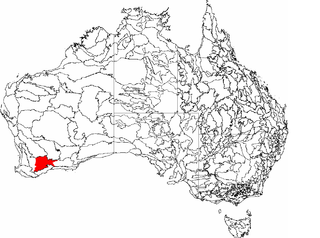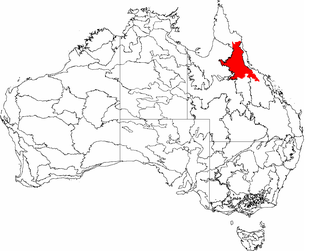Continental Stress Class is a method of describing the landscape health of biogeographic regions in Australia. There are six Continental Stress Classes with Class 1 containing the most stressed regions and Class 6 the least stressed and therefore most healthy. The classification takes into account indicators of landscape health such as the extent, condition, connectivity, and rate of clearing of native vegetation; changes to soil and hydrological conditions; the presence of feral plants and animals; the presence of threatened species and ecological communities; and threats such as dryland salinity; and fire regime.

Biogeography is the study of the distribution of species and ecosystems in geographic space and through geological time. Organisms and biological communities often vary in a regular fashion along geographic gradients of latitude, elevation, isolation and habitat area. Phytogeography is the branch of biogeography that studies the distribution of plants. Zoogeography is the branch that studies distribution of animals.

Australia, officially the Commonwealth of Australia, is a sovereign country comprising the mainland of the Australian continent, the island of Tasmania, and numerous smaller islands. It is the largest country in Oceania and the world's sixth-largest country by total area. The neighbouring countries are Papua New Guinea, Indonesia, and East Timor to the north; the Solomon Islands and Vanuatu to the north-east; and New Zealand to the south-east. The population of 26 million is highly urbanised and heavily concentrated on the eastern seaboard. Australia's capital is Canberra, and its largest city is Sydney. The country's other major metropolitan areas are Melbourne, Brisbane, Perth, and Adelaide.
Continental Stress Classes were first introduced by Gethin Morgan in 2001, in the report Landscape Health In Australia: A rapid assessment of the relative condition of Australia's bioregions and subregions. [1] Morgan gave a class to each of the Interim Biogeographic Regionalisation for Australia (IBRA) subregions, as follows:

The Interim Biogeographic Regionalisation for Australia (IBRA) is a biogeographic regionalisation of Australia developed by the Australian Government's Department of Sustainability, Environment, Water, Population and Communities. It was developed for use as a planning tool, for example for the establishment of a National Reserve System.
- Class One: 17 subregions, including the Avon Wheatbelt, the Tasmanian Midlands and numerous subregions in south eastern Australia, including most of Victoria;
- Class Two: 20 subregions;
- Class Three: 90 subregions;
- Class Four: 75 subregions;
- Classes Five and Six: 152 subregions.

The Avon Wheatbelt is an Australian bioregion in Western Australia and part of the larger Southwest Australia savanna ecoregion.

Victoria is a state in south-eastern Australia. Victoria is Australia's smallest mainland state and its second-most populous state overall, making it the most densely populated state overall. Most of its population lives concentrated in the area surrounding Port Phillip Bay, which includes the metropolitan area of its state capital and largest city, Melbourne, Australia's second-largest city. Victoria is bordered by Bass Strait and Tasmania to the south, New South Wales to the north, the Tasman Sea, to the east, and South Australia to the west.
The classification is now used by a range of federal and state government agencies in Australia.










